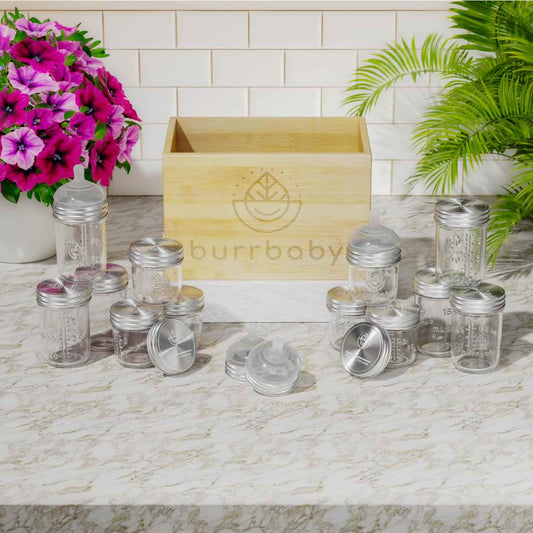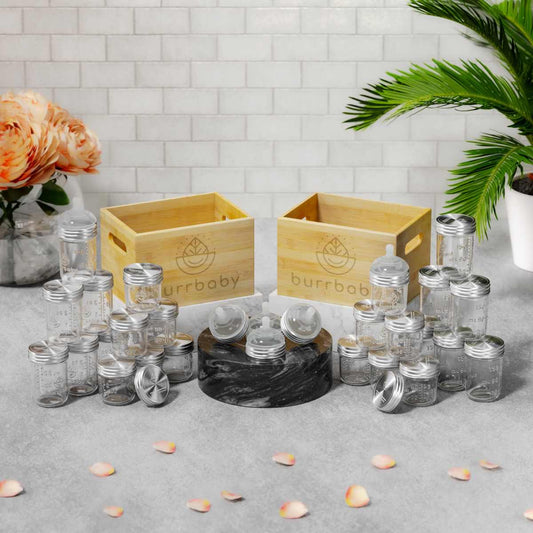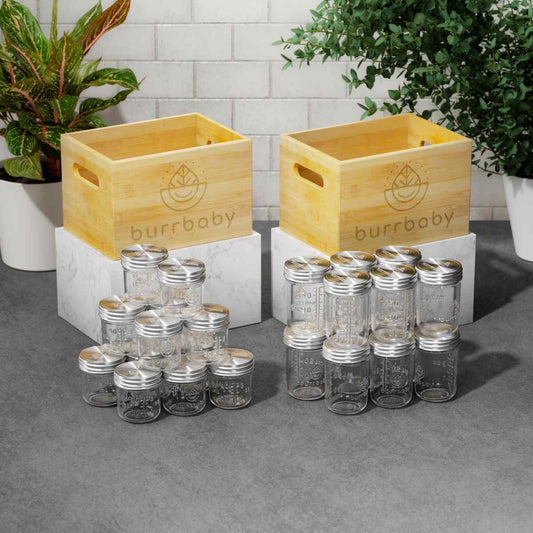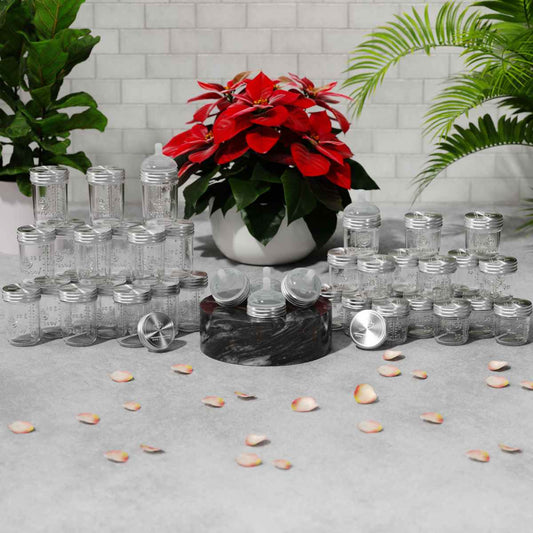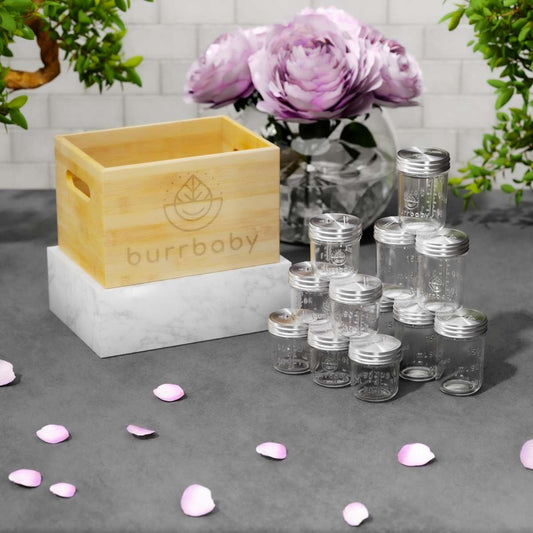Motherhood is a journey filled with joy, challenges, and decisions that can impact the well-being of your little one. One of the decisions we have to make revolves around how we store breast milk as we go back to work, to school, or any time we pump breast milk.
Breast milk is packed with essential nutrients, antibodies, and other nutrients that become a cornerstone of your baby’s health, so when we are out and about, we want our babies to still have access it, while making sure it stays fresh, safe, and doesn’t contain bacterial or chemical contaminants.
When we pump breast milk, we have to store it, and while storing it might seem simple, there is a lot we have to consider. In this article, we will dive into a ton of good information that should set you on the right path for how to safely store your breast milk.
At Burrbaby, we're dedicated to being a part of a healthier world for your children. We hope to accomplish this through our zero-plastic glass breast milk storage containers and bottles. These non-toxic, sustainable choices protect your baby's health and our planet.
Handling Breast Milk and Choosing the Right Containers for Storage
So, you just finished pumping, your freshly expressed breast milk is sitting in the pump reservoir, and you’re wondering what to do with it to it to keep it safe and ready for your baby. The first step is to make sure your hands are clean so you don’t accidentally add any external bacteria that could contaminate your milk.
Then, you need to transfer the breast milk to a storage container. There are an array of storage options available from disposable storage bags and plastic bottles to more health-conscious glass containers. Each choice comes with its own merits and drawbacks.
Disposable Plastic Breast Milk Storage Bags: Convenient and widely available, these might seem appealing. If you need a cheap, quick storage option, plastic bags will do. However, many parents don’t feel comfortable storing their baby’s sole source of nutrition in a bag made of synthetic chemicals (the same plastic as sandwich bags). They also will shed microplastics in your milk, which will be ingested by your baby.
Plastic Milk Storage Bottles: Reusable and often economical, plastic bottles have found their place in many households. Yet, concerns over chemicals and microplastics, which may leach into the milk, cause the same concern as plastic bags.

Glass Milk Storage Containers: Durable, reusable, and synthetic chemical free glass containers, like found in Burrbaby’s bundles, are a great option for parents who are concerned about the health of their baby and incorporate more eco=friendly parenting practices. Glass ensures that the milk remains uncontaminated and is much easier to clean and sanitize, keeping bacteria away. Burrbaby uses stainless steel lids, making them completely plastic free.
After choosing your preferred container, you'll have to transfer the milk from the pump to the storage. Here, steadily pour the milk from the pump to the storage container. Pouring into wide neck glass containers is much easier than trying to hold plastic bags open.
Once all the milk is in the milk storage container, every last drop, screw on the lid or seal the bag. The next step is determining where to store your breast milk.
Head here to read more about the benefits of using glass containers for breast milk storage.
Step-by-Step Guide: How to Store, Freeze, and Thaw Breast Milk
The way you store your breast milk depends on what you and your baby’s routine looks like. Will you be using the milk right away? Do you need to freeze the milk to build up a milk freezer stash? Let’s look at some breast milk storage guidelines to help make the choice easier.
Storing Milk at Room Temperature: If you plan to use the milk within 2 hours, storing it at room temperature is acceptable. A clean, cool surface away from direct sunlight is ideal. Remember, the clock starts ticking as soon as you finish pumping, so keep an eye on the time.
Keeping Breast Milk in the Refrigerator: For slightly longer periods of time, you can store breast milk in the refrigerator for up to 4 days if kept under 40 degrees F. Keep your milk in the back where the temperature will be the most consistent.
Freezing Breast Milk: If you're looking to build a reserve, the freezer, particularly in the back/bottom, is where breast milk can be stored safely for months. Breast milk expands as it freezes, so leave some space at the top to account for this. Organizing the milk chronologically and using specialized storage bmake sure to leave some space at the top of the container. For these extended periods, it’s extra important to have an airtight container with durable lids like Burrbaby’s with the stainless steel and silicone sealing bands.
Here is a more in-depth article on breast milk storage in the refrigerator and freezer.
Guidelines for Breast Milk Storage
It’s important to follow the guidelines set by organizations such as the Centers for Disease Control when storing breast milk. Here's a handy reference to make sure your baby always has access to fresh, nourishing milk:

Room Temperature: Up to 2 hours (about 77°F or cooler).
Refrigerator: Up to 4 days (at 40°F or colder).
Freezer: Up to 6 months (0°F or colder).
Whether using storage bags, plastic bottles, or glass containers, these best practices apply universally. But remember, these are general guidelines, and knowing your situation may call for adjustments. Always err on caution, prioritize cleanliness, and don't hesitate to consult healthcare professionals for personalized guidance.
Safety Precautions During Storage
How you store breast milk isn't as simple as popping a container into the fridge or freezer. Here's some extra steps to keep your precious liquid gold safe:
Ensure your breast milk storage containers are clean: From the moment you express the milk to the moment it reaches your baby, cleanliness is paramount. Wash your hands, sterilize glass containers, and always use fresh storage bags. The cleaner, the better.
Proper Labeling and Rotation: A well-organized milk stash makes sure your baby gets fresh milk every time. Label each container with the date and ensure that you follow the "first in, first out" rule, providing the freshest milk within the ideal time frame. Rotation is your friend. Use the oldest milk first, and put the freshest milk in the back to make it easier.
Precautions to Prevent Over-expansion: When freezing breast milk, allow space for expansion. Overfilled containers might crack or leak, and that's milk you don't want to lose.
Read more on breast milk storage safety and signs of spoilage here.
How to Thaw, Warm, and Feed Stored Breast Milk
So now you’ve expressed your breast milk with your pump, transferred it to a breast milk container, and you’ve found the best way to store it. Now, thawing and warming your breast milk are the final steps in the journey from mother to child. Here's how to ensure that this final step is done right to feed your baby.
Safe Methods for Thawing Breast Milk: Thawing breast milk isn’t super hard, but there are still best practices to follow. You can move the frozen milk to the refrigerator for slow, gentle thawing, or immerse the bottle or bag in a bowl of warm water for quicker results. Running warm water over the breast milk container also works, but wastes a bit more water than having warm water in a bowl. Remember to handle the container with care as a slip, drop or tear can cause spilled milk.

Warnings Against Improper Thawing or Heating Methods: Never ever use the microwave for heating up breast milk. Microwaving can create hot spots and destroy valuable nutrients. Stick to the bowl of warm water or a specially designed bottle warmer. For the same reason, never get the water too hot or boiling as that too can cause nutrients to break down.
It’s also important to avoid refrigerating or refreezing milk after it has been brought up to room temperature. This can cause extra bacterial growth that could hurt your baby.
Tips for Mixing Separated Milk Fats: It's natural for the fat in breast milk to separate during storage. Gentle swirling, rather than vigorous shaking, will mix it back without introducing air bubbles that could give your baby gas.
How to Know If Stored Breast Milk is Spoiled or Safe for Baby
Even if you take all the right steps to keep your stored breast milk safe, we should still be aware of the common signs that your milk has spoiled to keep your baby safe. It’s not likely, but preparation is power.
Signs of Spoiled Breast Milk: Trust your senses; if the milk smells sour or soapy or appears discolored, it may be time to discard it. The milk could have a separated fatty layer, which is normal, but there should be no chunks.
"First In, First Out" Rule: Consistency matters. Always use the oldest milk first, maintaining a system where the oldest milk is used first. We’ve talked about this already, but it deserves its own point. Label your containers with the date, time, and volume, and religiously organize your milk containers with the oldest in the front. Burrbaby’s storage jars make this easy with each lid having a place to write, and the bamboo organization boxes makes it easy to keep track of all your jars.
Having clean breast milk storage containers can help prevent contamination and having milk spoil. Here is more information on how to properly clean your breast milk storage containers.
Benefits of Health-Conscious, Eco-Friendly Storage Containers
In a world in need of better health and sustainability practices, why should raising our children be any different? Embracing eco-friendly and non-toxic solutions for breast milk storage is not just a trend; it's a testament to the love and care we place in our children and the planet they will inherit:

Choosing sustainable storage options safeguards your child's health and the planet they will inherit. Glass containers are free from synthetic chemicals and reduce waste. There are plenty of other benefits such as being much easier to use and more cost-effective, but those are secondary. Health and sustainability should be prioritized by all parents.
Burrbaby's non-toxic and sustainable breast milk storage jars and bottles echo your commitment to your child’s health and the future of our planet. When we were starting our family, we didn’t feel comfortable storing baby’s breast milk in containers that could leach synthetic chemicals and release microplastics, but there weren’t many good glass options available. So we started Burrbaby for our baby, and yours.
Wrapping Up
Proper breast milk storage is essential for maintaining its nutritional value and ensuring your child's safety. This guide has provided best practices for storing, freezing, and thawing breast milk, emphasizing efficiency and safety.
If you're looking for an eco-friendly and innovative solution, consider Burrbaby's storage products. They are designed with health, environmental sustainability and practical usability in mind, providing a great option for modern mothers.
Your choices in breast milk storage matter, so make them wisely. Utilize the guidelines provided here to make informed decisions to benefit your child and the environment.
References:
American Academy of Pediatrics Tips for Freezing and Refrigerating Breast Milk
Centers for Disease Control and Prevention (CDC) - Proper Storage and Preparation of Breast Milk



